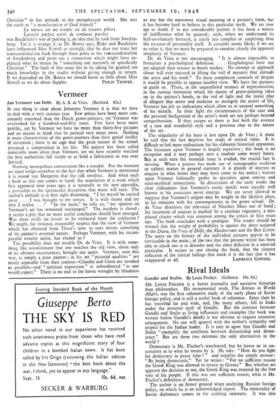Vermeer
Jan Vermeer van Delft. By A. B. de Vries. (Elmsford. 42s.) IF one thing is clear about Johannes Vermeer it is that we have to deal with a very curious case. Few artists have been more con- sistently esteemed than the Dutch genre-painters, yet Vermeer was overlooked for a hundred-and-fifty years. Few have been more prolific, yet by Vermeer we have no more than thirty-five pictures and no reason to think that he painted very many more. Nothing is more characteristic of the genre-painters than their genial facility of invention ; there is no sign that the great master of the school invented a composition in his life. No painter has been called inimitable more often than Vermeer, yet we have recently watched the best authorities fall victim to as bold a fabrication as was ever devised.
Nothing monopolises conversation like a scandal. For the moment we must resign ourselves to the fact that when Vermeer is mentioned it is round van Meegeren that the talk revolves. And when such book as this one comes to hand, the translation of a work which first appeared nine years ago, it is naturally to the new appendix, a postscript to the spectacular deception, that many will turn. The author's attitude is at first sight disarming. " I let myself be carried away . . . I was brought to my senses. It is with shame and joy that I realise . . ." " In the main," he tells us, " my opinion on Vermeer's art has remained unchanged." The incident is closed ; it seems a pity that no more useful conclusion should have emerged. Was there really no lesson to be extracted from the confusion ? We might, for instance, reasonably suspect that the view of Vermeer which has obtained from Thore's time to ours misses something of the painter's essential nature. Perhaps Vermeer, with his incom- parable evasive talent, has eluded us ?
The possibility does not trouble Dr. de Vries. It is with some- thing like astonishment that one watches the old view, shorn only of its obvious excrescences, brought out again. Vermeer, seen this way, is simply a pure painter ; in his art " pictorial qualities " are neatly separable from their content—Chardin and Corot are invoked as parallels—and " spiritual expression " is subordinated " as one would expect." There is no end to the havoc wrought by blindness
to any but the narrowest visual meaning of a picture's form, but it has become hard to believe in this particular myth. We are now apt to doubt if to any considerable painter it has been a matter of • indifference what he painted ; style, when we understand its half-involuntary betrayal, is rarely less complex or surprising than the recesses of personality itself. It certainly seems likely, if we are to value it, that we must be prepared to examine closely the apparent simplicity of Vermeer.
Dr. de Vries is not encouraging. " It is almost impossible to formulate a psychological definition. . . . Graphologists have not yet adapted their science to brush strokes. No attempt to approach closer will ever succeed in lifting the veil of mystery that shrouds the artist and his work." To these complacent counsels of despair it would be possible to oppose 'another view. We have the pictures to guide us. There, in the unparalleled manner of representation, in the curious formation which the matter of genre-painting takes on in the painter's hands, in the veil of light and the ironic play of allegory that arrest and enshrine so strangely the action of life, Vermeer has,left us indications which allow us to unravel something of his miracle. In their light the circumstances of the case and the personal background of the artist's work are not perhaps beyond comprehension. If they escape us there is lost both the essence of a rare and wonderful style and a precious clue to the nature of the art.
The singularity of his hero is lost upon Dr. de Vries ; it must be said that the fact deprives his study of critical value. It is difficult to feel more enthusiasm for his elaborate historical apparatus. The literature upon Vermeer is largely repetitive ; this book is no exception and it may perhaps save a student some weary hours. But at each turn the essential issue is evaded, the crucial fact is missing. When a painter has made use of iconographic tradition or subject matter in general currency it is plainly of interest to enquire in what forms they may have come to his notice ; writers upon Vermeer habitually prefer to speculate upon remote and semi-mythical connections. In discussions of the early works the clear indications that Vermeer's exotic motifs were equally well known to his associates never emerge. We are never allowed to suppose that Vermeer's origins may be sought in the likeliest place, in his relations with his contemporaries in the genre school. Dr. de Vries dismisses the relevance of Nicolaes Maes out of hand ; his treatment of sources is marked by a cautious vagueness, a mis- placed charity which was common among the critics of fifty years ago. The book concludes with a catalogue. The reader should be warned that the weight of probability is against the dates assigned to the Diana, the View of Delft, the Maidservant and the Beit Letter. The notes on the history of the individual pictures appear to be serviceable in the main ; of the two that the present writer has been able to check one is in disorder and the other deficient in a material particular. It occurs to one closing the book, that the clearest reflection of the critical failings that mark it is the fact that it has


































 Previous page
Previous page